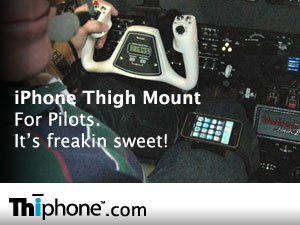Always Think Ahead

Every flight has a mission, a purpose, a reason why you will go through all the effort and expense of flying from point A to point B. Granted, some are a little more inventive than others – get breakfast, practice maneuvers, enhance your skills, impress that hot date with your mastery of the air. My last, er…mission was to take my flight instructor’s brother to Arkansas in order to pick up a new motorcycle. SWEET! The weather around here had been terrible for weeks and I hadn’t been able to do much flying, so I jumped at the chance. Being asked to fly 15+ hours roundtrip? VERY appealing. The night before the adventure began, I stopped by The Pilot Shop to pick up the most recent VFR and IFR charts. We were planning on going VFR the whole way, but just in case, I thought it best to pick up all the charts – call it my Boy Scout training. I planned the flight like I normally do, calculating that we would be flying for 1,000 miles, ground speed would be about 150 kts, and our fuel burn rate would be approximately 15 gph. We could fly for about 5 hours with the fuel capacity in my Cherokee, but I remembered that I still needed 30 minutes of reserve for daytime VFR flying. Therefore, our first stop would be in Virginia – we’d have breakfast, refuel and get back into the air.
We departed Islip (ISP) at 6:10 in the morning, taking off into some of the best weather in which I have ever flown. Skies were clear but pretty hot for that time of day, 14 degrees above standard at our flying altitude of 6,500 ft. We headed out over Manhattan, then over northern New Jersey and on into Pennsylvania, where we flew over some amazing countryside. As the terrain became more mountainous, I started thinking a lot about where I would land if I encountered any engine trouble.
I am always preparing myself for engine failure, even when cruising en route. When taking off, I watch my remaining runway while on the roll. If I have already left the ground, I just look straight ahead and think about where I could put her down as safely as possible. From my training and any number of NTSB reports, I know not to turn around and try to land on the runway. As most of my flying has taken place in the Northeast/New York City region, I know that there is almost always an airport along my route. It wasn’t until this trip out to the Midwest that I became aware of the glaring differences between the two regions. What happens when you are in between airports and you don’t have enough gliding distance to land at the next one? There’s definitely a lot more “in-between” between airports in the Midwest than over here.
Solution: you pick a field or the best open area you can, and put it down there. You must commit to your landing at that time and to that spot. Committing early to a location is critical to the success of an off-field landing. Don’t think “Oh, I’m only 10 miles from the next airport. I can stretch the glide.” That will get you killed. Did I say killed? Yes. Remember the old saying: Aviation is completely unforgiving to any carelessness or neglect. Please, don’t take my word for it – Sully Sullenberger, the ‘Hero of the Hudson,’ has publicly credited the success of his emergency landing partly to his early commitment to land in the Hudson and not trying to make Teterboro airport.
Once you’ve established your best glide speed and chosen your location, fly the airplane and set up a smooth, stabilized approach to that landing spot. One of the most important things I learned from my progress ride was that once best glide speed was established, my next job was to pick my spot (get it in view on the pilots side) and circle it until I reach an altitude where I can do a normal traffic pattern and landing (soft field if required). Whenever I fly, I am constantly going over these scenarios in my mind.
On the outbound flight my passengers (who are also CFI’s) insisted that I fly without the autopilot, so maintaining the crab for the wind and adjusting for the plane’s weight was interesting. My Cherokee was loaded to gross 3,400lbs – we had baggage in the front compartment, baggage in the middle row of seats, and since there was more leg room, one passenger in the far aft seat. Although we were well within the weight and balance limits of the aircraft, its performance was very different from what I was accustomed to. As loaded we were left side heavy so the plane kept wanting to bank to the left, which became even more pronounced while we burned fuel on that side. This is where I really applied what I learned in training, remembering that the plane will behave differently depending upon where the CG is located and what flight characteristics to expect. Of course, we could have been 50 pounds lighter if I hadn’t taken all those approach plates and charts with me….
After about 3 1/2 hours of flying, we decided to land at Huntington, West Virginia (HTS). We refueled and had a nice breakfast at the airport cafeĀL. This is a very relaxing airport, with rocking chairs in the waiting area. Once we finished eating, we hustled back to the Cherokee for the next leg of our trip.
Four hours later, we landed in Russellville, Arkansas (RUE). We were light on fuel and heavy in the back. On final I had some extra airspeed to compensate for the configuration, but I flared too high and the plane bounced. I knew not to try to save this landing, so I did a goaround – full power, accelerated to Vy, and retracted the flaps slowly. It was a good reminder that although certain aspects of flying are relatively rarely used, they still require a lot of practice. Go-around’s are a good example – practice them, especially if you haven’t done one in awhile. My second attempt at landing was much better.
On the return trip we came across this one small airport that really stood out among the many we passed. As we were flying alongside a mountain in West Virginia, I looked down and saw a runway. Nothing amazing, just a small county airport – a strip of asphalt surrounded by fields – but something about it was captivating. “Look at how beautiful that runway is,” I said out loud. My passengers agreed, which led to a discussion of how only pilots could look at 3,000 feet of pavement and call it beautiful. I think runways must be to pilots what golf courses are to a golfer – each one has its own characteristics, personality and beauty. We see these little strips staked out in fields, on roadsides, in the middle of nowhere, and we envision what it must be like to operate from them, what life is like at that small county airstrip. “Look at how beautiful that is” is a refrain I’d like to keep hearing myself say.
Attitude Checklist:
- It doesn’t matter where you are flying - always remember to look outside and check for places to land in case of an emergency.
- Don’t try to stretch a glide. Pick your landing spot and commit to it early.
- When flying an aircraft under conditions or configurations you are not used to always recheck your performance charts and calculate weight and balance limits.
- If you have a bad landing, or it looks like you will have a bad landing, GO AROUND.
- Always admire a pretty runway!






